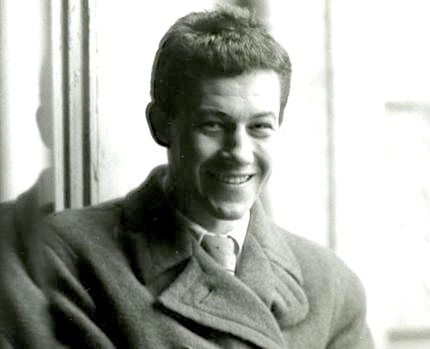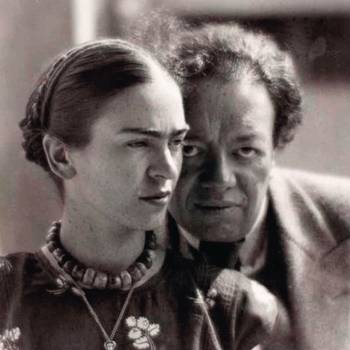“Unlike my father’s life, Frida Kahlo’s is widely known and her work provides considerable information about her personality and experiences. I wagered with myself that as I researched what she was doing in the months before they met, I would then have access to my father’s world. The one would bring to light the other…” – Author Marc Petitjohn
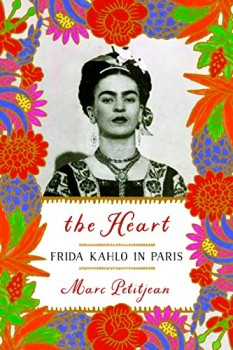 When author Marc Petitjean was contacted in Paris by a Mexican writer named Oscar, who wanted to meet him to talk about Marc Petitjean’s father Michel, the author’s interest was piqued. His father, a “left-wing militant” journalist, and associate of avant-garde artists and writers, had been dead for twenty years. When they met, Oscar pulled out a short manuscript he had written with information acquired from the archives of Mexican artist Frida Kahlo, indicating that she had had an affair with Michel Petitjean during the three months she had been in Paris from early January to late March, 1939. An affair between the author’s father and Kahlo was new information to son Marc Petitjohn, who almost dismissed it as “overblown.” Still, Frida Kahlo had given his father one of her best paintings when she returned to Mexico after that three-month visit in 1939. Ultimately, “Oscar’s curiosity kindled my own, and I in turn embarked on researching the lovers’ lives.”
When author Marc Petitjean was contacted in Paris by a Mexican writer named Oscar, who wanted to meet him to talk about Marc Petitjean’s father Michel, the author’s interest was piqued. His father, a “left-wing militant” journalist, and associate of avant-garde artists and writers, had been dead for twenty years. When they met, Oscar pulled out a short manuscript he had written with information acquired from the archives of Mexican artist Frida Kahlo, indicating that she had had an affair with Michel Petitjean during the three months she had been in Paris from early January to late March, 1939. An affair between the author’s father and Kahlo was new information to son Marc Petitjohn, who almost dismissed it as “overblown.” Still, Frida Kahlo had given his father one of her best paintings when she returned to Mexico after that three-month visit in 1939. Ultimately, “Oscar’s curiosity kindled my own, and I in turn embarked on researching the lovers’ lives.”
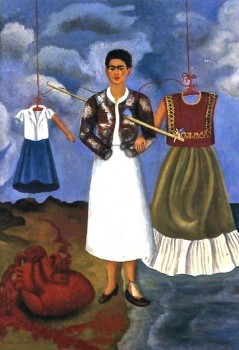
“The Heart,” a painting given to Michel Petitjean by Frida Kahlo during the three months she was his lover in Paris in 1939.
In the earliest pages of this book, the author is concerned about his faded memories of his father, whose relationship with Frida Kahlo took place twelve years before Marc Petitjean was born. As he presents his own discoveries about this period in the life of his father, including his father’s relationship with Frida Kahlo, however, Marc Petitjean cannot help but allow his personal feelings to shine through the narrative, making it come alive in ways unusual for non-fiction. One of his most vivid memories from childhood is of the painting Frida Kahlo gave to his father, one called “The Heart,” or “Memory,” which hung in the living room of the house where the author grew up. This painting disturbed him as a small child, with its “stark depiction of a huge, bleeding heart lying on the sand, and a woman with no hands whose body is pierced by a metal rod and whose eyes seemed to stare at me,” an image not unlike an accident Frida Kahlo herself had suffered as a teen. “The pain is so intense that the central figure is derealized and dismembered: her hands no longer belong to her, and her heart – a vital organ that is usually hidden and is the symbolic seat of emotions – is starkly exposed for all to see, and disconnected from her body.”
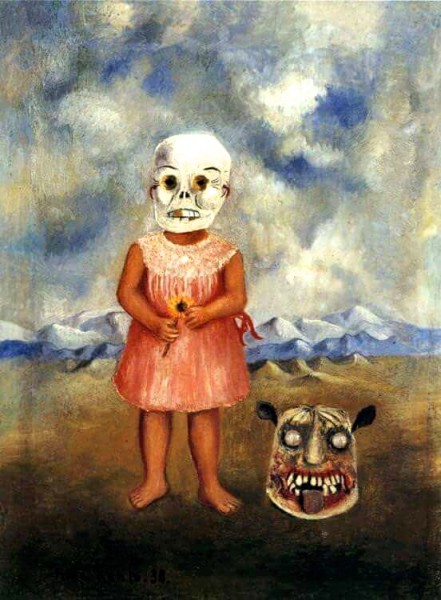
“Girl with Death Mask,” a painting that may have been of Frida as a child celebrating the Day of the Dead, a theme throughout her work.
From this startling beginning, the author develops a sensitive and insightful portrayal of Frida Kahlo’s first real love affair in Paris, following her husband Diego Rivera’s sudden declaration in Mexico, earlier that year, that he wanted a divorce. This was to be Frida Kahlo’s only trip to France, a three-month visit during which her friend Andre Breton had promised her a show of her paintings there, and a new focus to her life. Upon her arrival in Paris, she is greeted by Andre Breton’s wife, Jacqueline Lamba; Dora Maar, Pablo Picasso’s partner; and Andre Breton, who guide her to his house, where she will stay. Breton and Jacqueline Lamba live in a small, two-room apartment, however, and Frida Kahlo is to sleep in the tiny bed belonging to their four-year-old daughter, who will share the room. Unfortunately, Breton has not thought far ahead in other respects regarding the visit. He has not bothered to claim all Frida’s paintings for the “show,” which are still languishing at Customs, and he has not yet found a gallery in which to exhibit her work. He has promised to write an introduction to her work for her show, but that has not been started yet, his callous treatment of his guest giving new meaning to the word “surreal.” Ultimately, it is Michel Petitjean, the author’s father, who pays to retrieve Frida’s paintings from Customs and who helps to set up a display of her paintings.
The developing love story of Frida Kahlo and Michel Petitjean is inextricably connected with the fraught pre-war political atmosphere of Paris in 1939, the boiling artistic and philosophical ferment of the period, and the close, interconnected friendships among Andre Breton, Marcel Duchamp, Pablo Picasso, Joan Miro, Man Ray, and others. Even designer Elsa Schiaparelli, “the queen of Paris fashion,” promises to create a dress for Frida based on the Mexican designs she loves, though there is no record that Schiaparelli ever completed such a dress. Somehow, perhaps through celebratory parties connected to the eventual showing of some of Frida’s paintings, she and Michel Petitjean become especially friendly, and Michel ultimately pauses his relationship with another woman, with whom he had been having an affair for three years. He has stated in interviews that he remembers “his first night with Frida because it was the day Barcelona fell, ” January 26, 1939, a prelude to the inevitable fall of Franco’s Spain and the political and social crisis that results throughout Europe.

Author and cinematographer Marc Petitjean, who tells the story of his father’s relationship with Frida Kahlo in this book.
A childhood victim of polio, a paralyzed foot, loss of toes, and long convalescences – including one in which she had to recover from a broken pelvis and vertebrae after being speared by a metal handrail, when she was struck by a trolley as a teenager – Frida Kahlo suffers pain for most of her life. Death seems ever present to her, and she uses all her energy to ward it off with “a stream of drinking binges, love affairs of varying durations, passionate friendships, and political fervor.” She spends time in the hospital in Paris, and her “idyll” with Michel Petitjean is affected by her health. Still, she is moved and excited by the eventual showing of her work and the compliments she receives from Joan Miro, Kandinsky, Picasso, Marcel Duchamp, and “other big cacas of Surrealism.” When she finally departs from France after three months, Michel Petitjean has thought ahead to have letters and notes delivered to her along the way. As he says, “Frida was a lady on an extraordinary scale in terms of dignity, and precision. She was naturally distinguished, it wasn’t something she could have learned. She had great nobility, she was a real princess.” Author Marc Petitjean has guaranteed through the personal details he includes that readers of this book will also see her in that same regard, perhaps one of the few times that words like “nobility,” “lady,” “dignity,” and “princess” are highlighted in Frida’s unconventional and tumultuous life.
Photos. The painting of “The Heart” (1937) was given to Michel Petitjean and was in the living room of the house where author Marc Petitjean grew up. He was afraid of this painting for much of his childhood. https://www.fridakahlo.org
“The Girl with the Death Mask,” which may have been Frida’s interpretation of herself as a young girl celebrating the Day of the Dead, appears on https://www.fridakahlo.org
Michel Petitjean, 1937, at about the time of his affair with Frida Kahlo in Paris. https://www.abc.es
Author and cinematographer Marc Petitjean, who tells the story of his father’s relationship with Frida Kahlo in this book. https://otherpress.com
Frida Kahlo with her estranged husband Diego Rivera, during the time that she was in Paris. Estate of Martin Munkacsi, courtesy of Howard Greenberg Gallery. https://www.christies.com
